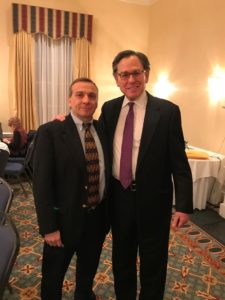 As mentioned last time, Lincoln: The Fire of Genius is now open for pre-order on Amazon and Barnes and Noble (click on the respective links to pre-order). I’m honored that journalist Sidney Blumenthal penned the Foreword for the book.
As mentioned last time, Lincoln: The Fire of Genius is now open for pre-order on Amazon and Barnes and Noble (click on the respective links to pre-order). I’m honored that journalist Sidney Blumenthal penned the Foreword for the book.
Blumenthal is arguably one of the most astute political observers in the nation. He is also a highly regarded (and highly successful) biographer of Abraham Lincoln. The first three volumes of his planned five-volume treatise on The Political Life of Abraham Lincoln have won many accolades for his depth of research, insight, and writing style. Each volume has won numerous writing awards, including the Lincoln Book Award from the Abraham Lincoln Institute and the Book Prize from The Lincoln Forum.
Previously a staff reporter for The Washington Post and a Washington editor and writer for The New Yorker, Blumenthal has also had commentary routinely published in Vanity Fair, Salon, The Guardian, and many other media outlets. In addition to his highly regarded Political Life of Abraham Lincoln series, it was his July 17, 2020 article in Washington Monthly that caught my attention. On that date I was just about to push the “Send” button to get my final proposal for The Fire of Genius to my literary agent for presentation to publishers. I immediately sent off an email to Blumenthal, who quickly agreed to write a Foreword for the book. I had previously spoken with Blumenthal about the concept, and he had encouraged me to write it, noting that “a full book on Lincoln’s interest in science and technology was needed.” Given my long career in science combined with my lifetime independent study of Abraham Lincoln, I was the perfect person to write it. With his approval, I added his name to my proposal and sent it off. A few months later I had a signed contract with Rowman & Littlefield, for publication under their Lyons Press imprint.
In his Washington Monthly article, Blumenthal argued that “Lincoln’s commitment to science was central to his rise, who he became, how he won the Civil War, and to the United States becoming a modern nation.” This is exactly the theme of my book, so it was almost ordained that he write the Foreword.
He ends his Foreword for the book with the following paragraph:
It became more than an accident of time and sheer coincidence that an ocean apart Abraham Lincoln and Charles Darwin were born on the same day, February 12, 1809. The child born to a poor dirt farmer in Kentucky and the one born into a wealthy English family wrought revolutions and emancipations. Lincoln was the vindicator of liberal democracy of, by and for the people. Darwin was the scientific voyager of The Origin of the Species and The Descent of Man, of evolution, natural selection and the diversity of life. But in Lincoln’s case the division between statesmanship and science is unnatural. David J. Kent’s invaluable history shows us how Lincoln’s fire of genius was to fuse those elements in order to create a “new birth of freedom.”
Lincoln: The Fire of Genius tells the story of how science and technology gradually infiltrated Lincoln’s remarkable life and influenced his growing desire to improve the condition of all men. It’s a story of how we became a modern nation.
Pre-order is now open on Amazon and Barnes and Noble (click on the respective links to pre-order). The price will inevitably drop before the final shipment, and any pre-orders will automatically get charged the lower price at fulfillment. Pre-ordering now helps the publisher get a sense of the interest, which could mean a bigger print run. So please go ahead and pre-order without worries. While you’re there, check out my other books.
The book is also listed on Goodreads, the database where I keep track of my reading. Click on the “Want to Read” button to put it on your reading list. That will also ensure you get informed of the release date AND will let you try for one of ten free hardcover copies of the book that I’ll be giving away this summer. I’ll also be giving away as many as a hundred e-books. [And yes, the book will also be put out on audio]
David J. Kent is President of the Lincoln Group of DC and the author of Lincoln: The Man Who Saved America. His previous books include Tesla: The Wizard of Electricity and Edison: The Inventor of the Modern World and two specialty e-books: Nikola Tesla: Renewable Energy Ahead of Its Time and Abraham Lincoln and Nikola Tesla: Connected by Fate.
Check out my Goodreads author page. While you’re at it, “Like” my Facebook author page for more updates!
[Photo: David J. Kent and Sidney Blumenthal, author photo]



 Few people know that Abraham Lincoln was also a philanthropist. We remember him for saving the union and the
Few people know that Abraham Lincoln was also a philanthropist. We remember him for saving the union and the 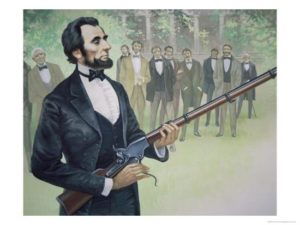 Lincoln took a scientific approach to military strategy. The Anaconda plan’s focus was on securing the coastlines and the Mississippi River. Recognizing New Orleans as the hub of the cotton trade and commerce, Lincoln saw it as the first port to be targeted for blockade. He also hoped to block southern ship traffic from Charleston, South Carolina to cut off Confederate attempts to woo Great Britain and France to their side. Helping him make this happen was Alexander Dallas Bache and the Coast Survey. The Coast Survey had been authorized by Thomas Jefferson, and Bache, who was Benjamin Franklin’s great-grandson, was quick to send nautical charts of the Chesapeake Bay to Lincoln. He also forwarded two terrestrial maps produced by the Survey that had far-reaching influence on Lincoln’s decisions on emancipation and military strategy.
Lincoln took a scientific approach to military strategy. The Anaconda plan’s focus was on securing the coastlines and the Mississippi River. Recognizing New Orleans as the hub of the cotton trade and commerce, Lincoln saw it as the first port to be targeted for blockade. He also hoped to block southern ship traffic from Charleston, South Carolina to cut off Confederate attempts to woo Great Britain and France to their side. Helping him make this happen was Alexander Dallas Bache and the Coast Survey. The Coast Survey had been authorized by Thomas Jefferson, and Bache, who was Benjamin Franklin’s great-grandson, was quick to send nautical charts of the Chesapeake Bay to Lincoln. He also forwarded two terrestrial maps produced by the Survey that had far-reaching influence on Lincoln’s decisions on emancipation and military strategy. I have just read your dispatch about sore tongued and fatigued horses. Will you pardon me for asking what the horses of your army have done since the battle of Antietam that fatigue anything? A. LINCOLN
I have just read your dispatch about sore tongued and fatigued horses. Will you pardon me for asking what the horses of your army have done since the battle of Antietam that fatigue anything? A. LINCOLN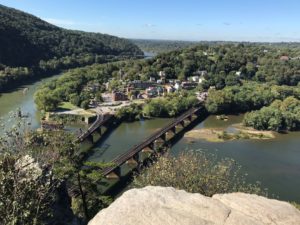 President Lincoln took a special train to Harpers Ferry on October 1, 1862. I drove my car to the National Park Service visitors center on October 1, 2021. Lincoln reviewed the troops on Bolivar Heights. I climbed to the overlook on Maryland Heights. One hundred and fifty-nine years separated us, but I still felt his presence.
President Lincoln took a special train to Harpers Ferry on October 1, 1862. I drove my car to the National Park Service visitors center on October 1, 2021. Lincoln reviewed the troops on Bolivar Heights. I climbed to the overlook on Maryland Heights. One hundred and fifty-nine years separated us, but I still felt his presence.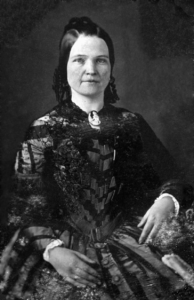 On this auspicious date in 1844, Mrs. Lincoln bought material to make corsets. Six yards of “gimp,” which was a strong twisted silk, wool, or cotton (not to be confused with the plastic form of gimp I used in Boy Scouts), along with ample amounts of lace. Presumably she already had whalebone or simply used over-starched fabric for stiffness. As critical as this was for containing the spreading remnants of Robert’s birth the previous year, this was only one of many important events happening on
On this auspicious date in 1844, Mrs. Lincoln bought material to make corsets. Six yards of “gimp,” which was a strong twisted silk, wool, or cotton (not to be confused with the plastic form of gimp I used in Boy Scouts), along with ample amounts of lace. Presumably she already had whalebone or simply used over-starched fabric for stiffness. As critical as this was for containing the spreading remnants of Robert’s birth the previous year, this was only one of many important events happening on  On August 10, 1863, Abraham Lincoln met with Frederick Douglass in the White House. Douglass had arrived unannounced, accompanied by Kansas Senator Samuel Pomeroy. They found the waiting room filled with people seeking an audience with the president, so Douglass, dressed in a dark suit on this sweltering August morning, assumed he would have a long wait. Instead, Lincoln’s secretary John Hay came quickly out to greet him and usher him into the inner sanctum.
On August 10, 1863, Abraham Lincoln met with Frederick Douglass in the White House. Douglass had arrived unannounced, accompanied by Kansas Senator Samuel Pomeroy. They found the waiting room filled with people seeking an audience with the president, so Douglass, dressed in a dark suit on this sweltering August morning, assumed he would have a long wait. Instead, Lincoln’s secretary John Hay came quickly out to greet him and usher him into the inner sanctum.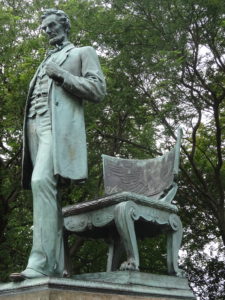 On March 30, 1861, Abraham Lincoln writes to Illinois State Auditor Jesse K. Dubois, who is “sorely disappointed” that Lincoln did not name J. P. Luse to head Minnesota’s Indian Affairs office. The letter gives a glimpse into the difficulties Lincoln faced dealing with our historical treatment of Native Americans.
On March 30, 1861, Abraham Lincoln writes to Illinois State Auditor Jesse K. Dubois, who is “sorely disappointed” that Lincoln did not name J. P. Luse to head Minnesota’s Indian Affairs office. The letter gives a glimpse into the difficulties Lincoln faced dealing with our historical treatment of Native Americans.  On March 11, 1862, everyone was thinking about George B. McClellan. Lincoln’s cabinet met and groused about their chronic dissatisfaction with the General. Frustrated with McClellan’s “slows,” Lincoln issued War Order No. 3, which fired McClellan as General-in-Chief but retained him as commander of the Army of the Potomac. He spent the rest of the day explaining his decision.
On March 11, 1862, everyone was thinking about George B. McClellan. Lincoln’s cabinet met and groused about their chronic dissatisfaction with the General. Frustrated with McClellan’s “slows,” Lincoln issued War Order No. 3, which fired McClellan as General-in-Chief but retained him as commander of the Army of the Potomac. He spent the rest of the day explaining his decision. 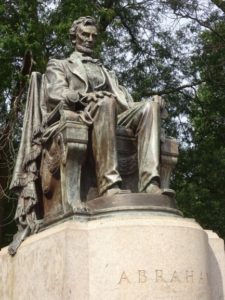 San Francisco targets Abraham Lincoln schools for renaming. Chicago targets Abraham Lincoln and other statues for possible removal. DC Congressional Delegate Eleanor Holmes Norton introduces a bill to remove the Emancipation Memorial statue in Washington, D.C. These efforts are severely misguided, based on political expediency rather than an informed discussion of Lincoln and other past American leaders.
San Francisco targets Abraham Lincoln schools for renaming. Chicago targets Abraham Lincoln and other statues for possible removal. DC Congressional Delegate Eleanor Holmes Norton introduces a bill to remove the Emancipation Memorial statue in Washington, D.C. These efforts are severely misguided, based on political expediency rather than an informed discussion of Lincoln and other past American leaders.






